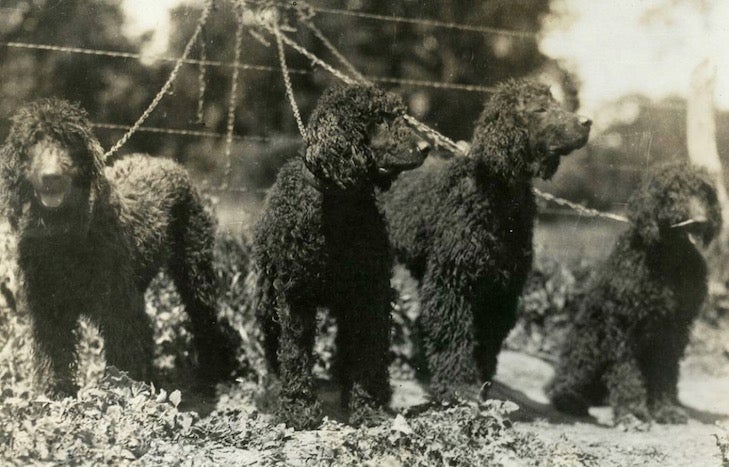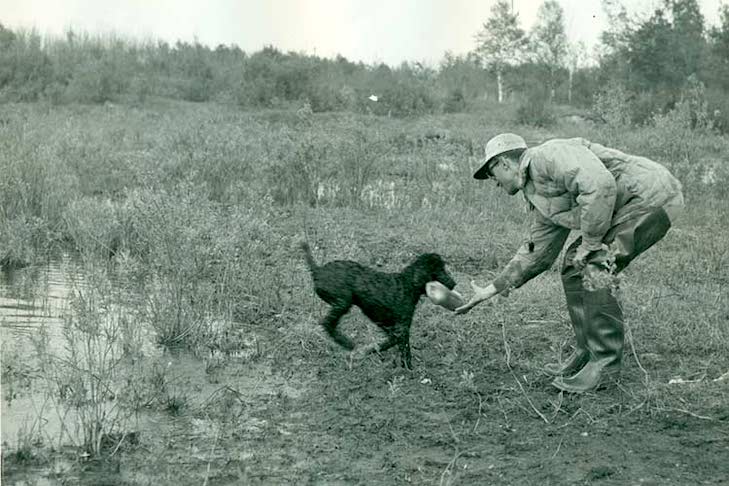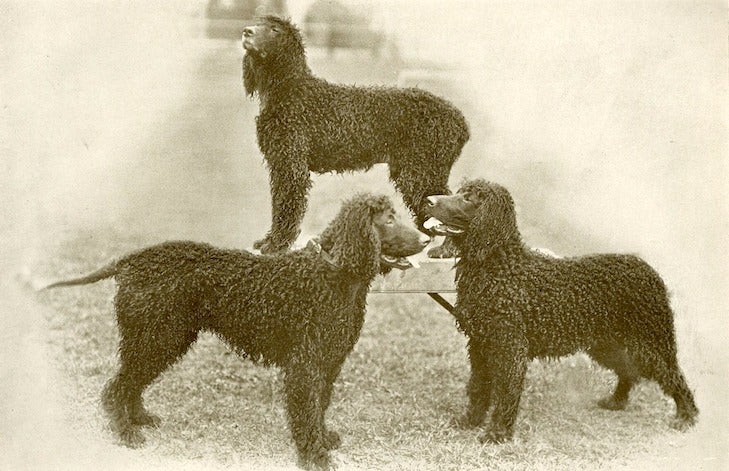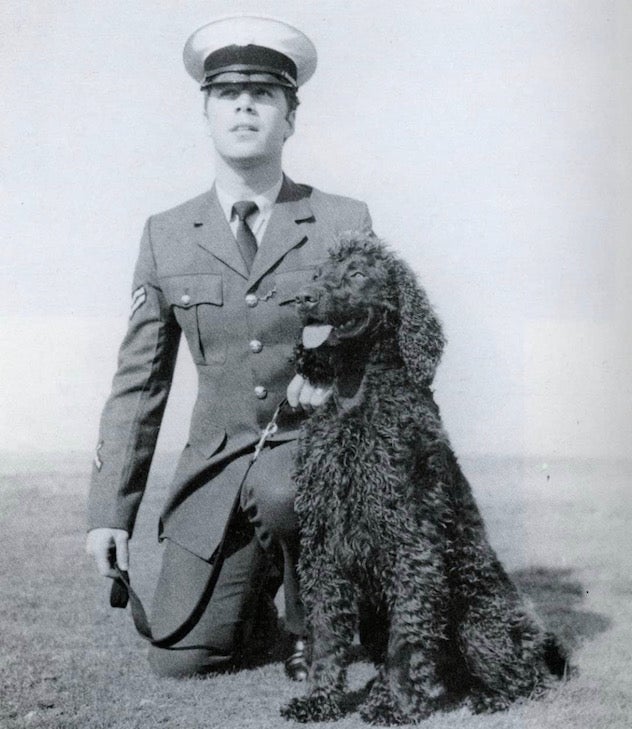
One of these things is not like the others, goes that classic Sesame Street song.
And in the Sporting Group, that applies to the Irish Water Spaniel.
Despite the spaniel affiliation mentioned in its very name, this versatile, water-loving bird dog is historically a retriever (though it can take part in AKC flushing spaniel tests). Its characteristic rat tail, distinctive enough to have earned the breed the nickname “Whip Tail” and “Rat Tail,” is not found in any other breed. Setting it apart even further, the Irish Water Spaniel’s eager and independent-minded character is in sharp contrast to the mild tractability of most British-derived retrievers and spaniels.
And while Ireland is “geographically” part of the British Isles, whose many sporting breeds are often interrelated through common ancestors, the Irish Water Spaniel has an opaque history, as curious as its purple-tinged, almost eggplant-colored coat.
With all these departures from the rest of the Sporting family, to say nothing of traditional spaniels over which it towers, the Irish Water Spaniel stands apart, reinforcing the idea that it partly descends from a unique, aboriginal Irish dog whose identity has been lost to the mists of time. Given that dogs used specifically to hunt waterfowl in Ireland have been documented as early as the 1600s, that certainly seems plausible.

How Did The Irish Water Spaniel Originate?
In the absence of more specifics, theories of course abound. Let’s start with the most fanciful, if only for the pleasure of indulging in some good, old-fashioned Irish storytelling: Folklore on the isle holds that these curly-coated, puce-colored dogs descended from the Dobhar-chú, which literally means “water hound,” an ancient Gaelic name for the otter. A dog-like, water-dwelling creature, the mythical Dobhar-chú did indeed resemble an otter, but was as big as a crocodile – and with a temperament to match. Sort of the canine equivalent of the Loch Ness Monster, it was said to be carnivorous, and aggressive to humans and dogs alike.
For a more feasible creation story, we can turn to Justin McCarthy, the Dublin sportsman, attorney and “father of the breed” who standardized the Irish Water Spaniel over the span of a few years in the 1830s. Since his work took place at a time before dog shows and formal pedigrees, he didn’t leave detailed records of the dogs he used to produce water spaniels such as Boatswain, the prototypical Irish Water Spaniel and prepotent sire who was bred, according to McCarthy, to “bitches from all parts of Ireland ‘of the proper type.’” Because of all these romantic conquests, Boatswain is in the pedigree of every Irish Water Spaniel alive today.
(With its sailing connotations, Boatswain – pronounced “BOW-sn” – was apparently a popular 19th-Century moniker for water-loving British breeds: The poet Lord Byron penned an ode to his Newfoundland of the same name when the latter died of rabies in 1808.)
Many breed histories maintain that the Irish Water Spaniel resulted from two liver-colored water spaniels: the now-extinct wavy-coated North Country Water Spaniel from the north of Ireland, which had longer legs, shorter ears, and a feathered tail; and the curly-coated Shannon Spaniel from the south and west of Ireland. With its longer ears and curly coat, the South Country Irish Water Spaniel more closely resembled today’s breed.
Despite this belief that the breed was the result of Irish stock, modern DNA analysis has uncovered strong genetic influences from the European continent – specifically the Poodle, Barbet, and Portuguese Water Dog, which would explain the Irish Water Spaniel’s crisply curled coat, love of water, resistance to frigid conditions and dashing temperament.

A World of Genetic Possibilities
Breed experts have noted a striking similarity in coat pattern between the Irish Water Spaniel and the Afghan Hound. Despite their significant differences, both breeds share the same smooth face, bare ankles, longer coat on the legs and – each’s crowning glory – topknot, which often cascades over the eyes.
While similarities to the Middle East’s Afghan Hound is likely just coincidental, McCarthy did travel more than once to France, where he would have had access to the Poodles, Barbets, and possibly Porties that have left a residual mark in the Irish Water Spaniel’s genome. If this was the case, the conclusion can be drawn that he was more focused on creating a new breed rather than preserving a long-established one.
It is also possible that McCarthy used breeds that were more readily available in Ireland and the United Kingdom. In a letter to a dog magazine of the period, McCarthy noted that the Irish Water Spaniel could not maintain its type when crossed with any breed other than the Bloodhound, which would add desired length of ear and improve scenting ability.
While at first glance that seems improbable, an infusion of genetics from that substantial Scenthound would have also added a low set to the ear and the bone needed for working in treacherous bogs, and ice-cold lakes and seas. The fact that Bloodhound blood was also added to another quintessentially Emerald Isle breed, the Irish Setter, suggests that the cross might have been an inspired one.

Today’s Irish Water Spaniel
Despite its rarity today, the Irish Water Spaniel was an incredibly popular show dog during the Victorian era. In fact, it was one of the nine original breeds recognized by the fledgling American Kennel Club when it was founded in 1884.
Today, many prospective owners today are drawn to the many variants of “Doodle” designer dogs, seeking an often-“hypoallergenic” companion with a textured coat and clownish personality. It’s a pity they don’t realize those traits already exist in this charming Irishman – albeit with a bold and eager streak that can be a challenge for the amateur owner.
To amend the Ernie-crooned ditty that started this article, one of these may not be like the others. But in the case of the Irish Water Spaniel, it most certainly does belong.


